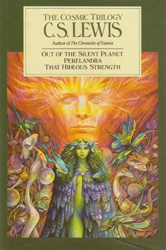The Cosmic Trilogy

Lewis, C.S. The Cosmic Trilogy: Out of the Silent Planet, Perelandra, and That Hideous Strength. London: The Bodley Head, 1990. 651 pp. ISBN 0-370-31439-5.
Reviewed by Nancy-Lou Patterson
[This review originally appeared as “A Unique Thing.” Mythlore 17.1 (#63) (1990): 45-46.
At Last! A handsome volume with a beautiful dustjacket by Brian Froud presenting the entire Ransom trilogy or Interplanetary trilogy, or, as phrased here, The Cosmic Trilogy of C.S. Lewis, ready to delight new readers. As Sir Hugh Walpole said of Out of the Silent Planet (1938), one may say of the complete trilogy,
It is of thrilling interest as a story, but it is more than that; it is a kind of poem, and it has the great virtue of improving as it goes along. It is a unique thing, full of stars, cold and heat, flowers of the planets and a sharp sardonic sense of humour.
Long available only in tiny individual hardbacks or a few endlessly repeated paperback editions, at last there is a volume of Lewis’s science-fiction masterpieces to set on the shelf beside The Faerie Queene, the Mort’ d’Arthur, and The Lord of the Rings as essential books of fantasy for adults.
Once upon a time, as an undergraduate, single and far from home, I spent an hallucinatory afternoon, and having slept past noon at the end of a long working summer in my twentieth year, and awakened to pick up a friend’s battered paperback of Out of the Silent Planet, I began to scan it. To my pre-Christian eyes it was exciting science fiction and nothing more; the author’s name meant nothing to me. Four years later, a married woman and a new-made Christian, pregnant with my first child, I began to read a set of paperbacks recommended to me by an Episcopalian university chaplain, and the scales fell from my eyes as I explored the starry worlds and flowery planets of the writer whom I now recognized as C.S. Lewis. The ground was prepared and the flowers took root.
In Out of the Silent Planet, a young philologist, Ransom, is dragooned by the scientist Weston and his cohort Devine to a space flight to Mars, taking another man’s place as a human sacrifice; in this sharpened, chilly, ageing world he becomes instead a friend of the indigenes, a variety of species who can communicate by speech across genetic barriers. With the help of spiritual beings he foils the plans of his captors and returns to earth, where he tells his story to the narrator Lewis. In Perelandra, a tougher and more experienced Ransom is called to duty by his spiritual masters, and travels to Venus, where with terrible effort he foils a far more terrible plan to subvert the first female of a new race through the devil-infested body of his old enemy Weston, returning as before to tell the tale to Lewis. In That Hideous Strength the Silent Planet, earth, so-called because it is in quarantine from the rest of the solar system, becomes the setting. Ransom, now remade by his supernal sojourns into the guru of a tiny religious community of humans, plants, and animals, and re-named Mr. Fisher King, waits with a wounded heel while his surrogates, a young couple named Jane and Mark Studdock, risk everything in contact with the spirits of the age (as a malignant organization, the N.I.C.E., masquerading as the cutting edge of science, technology, and social control, and inwardly in the grip of diabolical forces), until Merlin, raised from long sleep, returns to serve as a lightning rod who draws down the angelic forces of the cosmos to destroy this latest attack upon humankind. In the end Ransom is carried away to Perelandra like Arthur to Avalon, and the young couple are reconciled as it were, truly married in an eucastastrophic finale as described by the narrator Lewis.
I still find The Cosmic Trilogy to offer an instant and endlessly renewed virginity to the soiled and aching spirit; this is the very cosmos renewed, fresh and pristine as on the first day of creation. Out of the Silent Planet is a fine, fresh-aired, masculine book, befitting its setting on Malacrandra, which we know as the red star Mars. Perelandra, set on Venus, the Morning and Evening Star, explores the mystery of temptation and salvation in a world redolent of nectared femininity. And That Hideous Strength, my favorite book in the world next to George MacDonald’s The Princess and the Goblin, is a garden of earthly and heavenly delights, as richly tapestried as the gown of the Virgin Queen Elizabeth I, that lady of masculine will and feminine way (or, contrariwise, of feminine will and masculine way), a splendid, complex, astounding, terrifying, unforgettable nuptial romp full of angels, devils, gods and goddesses, fools, sages, saints, sinners, animals, humans, gardens, forests, prisons, mansions, crypts, and marriage chambers, not to say university quads and playing fields and common rooms, which celebrates once and for all the wedding of the genders, the syzygy of humanity and divinity which is humankind, the lords and ladies of our own blue planet Earth whose day, like the ancients, we are beginning again (and on Lewis’s strong advice) to celebrate.

